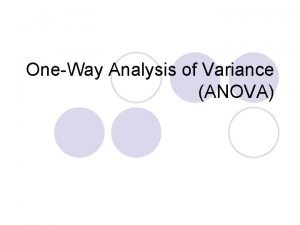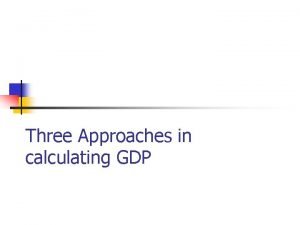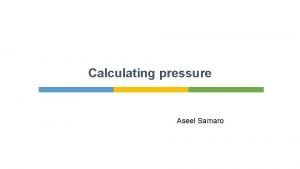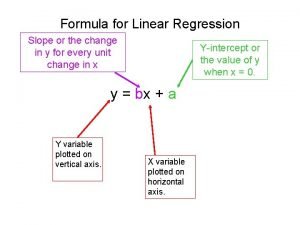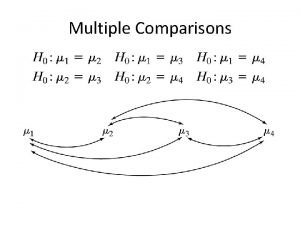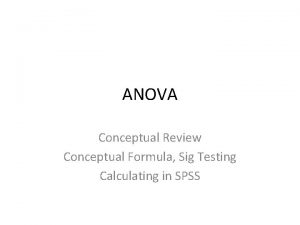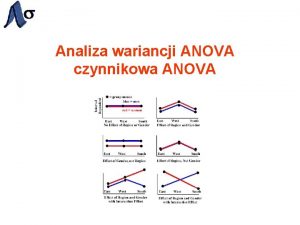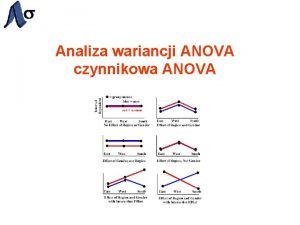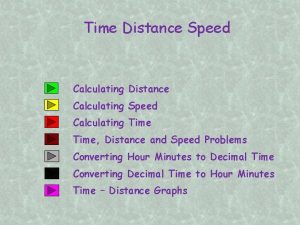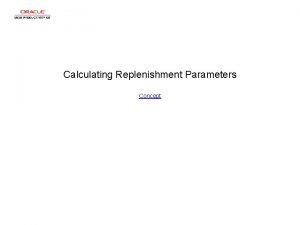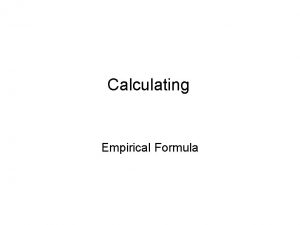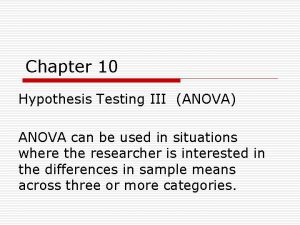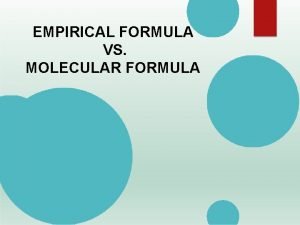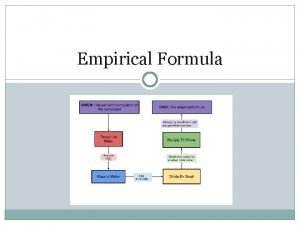ANOVA Conceptual Review Conceptual Formula Sig Testing Calculating



















- Slides: 19

ANOVA Conceptual Review Conceptual Formula, Sig Testing Calculating in SPSS

ANOVA as extension of t-test • T-test = difference between two means – Univariate/1 sample • Population mean compared to sample mean – Bivariate/2 sample • Compare sample means across two categories (males vs. female, old vs. young, white vs. nonwhite). • ANOVA • Compare sample means across three or more categories • Can no longer calculate a simple “difference between means”

The Logic of ANOVA • Instead of difference between means, analyze “variance” – Variance = sum of squared deviations from mean appropriate df – Between group variance • Measure of how group means vary around “grand mean. ” Larger mean differences produce larger values – Within group variance • Measure of how cases vary around their group mean. Considered “error” or “unexplained” variance, because it cannot be accounted for by the IV.

The F Ratio F = Mean square between = Explained variance Mean square within Unexplained variance • Mean squared = variance = Sum of Squares df – df for between = (number of groups – 1) • Or, K-1 – df for within = (N – number of groups) • Or, N - K

Use ANOVA when… • IV = nominal/ordinal with more than 2 categories • DV = interval ratio • Example – Instructor Iggy believes that the custody level of a prison is related to the number of prison infractions that an inmate accumulates in a year • NULL? µmin= µmed = µmax • NOTE: NO DIRECTIONALITY HERE!!

Random sample of three prisons N = 15 (5 for each prison). minimum medium maximum Xmin (xmin - xmin )2 Xmed (xmed - xmed )2 Xmax (xmax - xmax )2 1 1 4 2. 56 8. 04 2 0 6. 16 10 3. 24 3 1 7 1. 96 7 1. 44 2 0 5. 36 9. 64 2 0 6. 16 7 1. 44 ________________________________ 10 2 28 5. 2 41 6. 8 _________________________________ xmin=2. 0 xmed=5. 6 Grand mean = 5. 267 xmax=8. 2

Conceptual Plot of the 3 groups GRAND MEAN = 5. 27 • Based on all cases from all groups 1 2 3 4 BLUE: Minimum security (mean = 2) GREEN: Medium security (mean = 5. 2) RED: Maximum security (mean = 6. 8) 5 6 7 8 9

Types of Variation (SS) • Within group variation (error variation) – Add the variation from within each group together • SSminimim + SSmeduim + SSmaximum • 2 + 5. 2 + 6. 8 = 14 • Between group variation (explained variation) (grand mean - xmin)2 * Nmin + (grand mean - xmed)2 * Nmed + (grand mean - xmax)2 * Nmax = [(5. 27 -2)25] + [(5. 27 -5. 6)2 5] + [(5. 27 -8. 2)2 5] 53. 6 +. 56 + 43 = 97. 16

Variation Variance • Variation = sum of squared deviations (SS) Variance = mean sum of squares (mean square) – Divide SS by appropriate degrees of freedom • SS within/N-K = within mean squared • SS between/K-1 = between mean squared – K means the number of groups – Prison Example • Within variance = 14/(15 -3) = 1. 17 • Between variance = 97. 16/(3 -1) = 48. 58

Variance F ratio • F = Between variance / Within Variance • Prison Example Fobtained = 48. 58/1. 17 = 41. 5 With an alpha of. 05, Fcritical (2, 12) = 3. 88 Reject the NULL hypothesis that the mean number of infractions across the different types of prison are equal (That prison type and number of infractions are unrelated) • The odds of getting an F of 41. 5, if the null was true, is much less than 5%

Like “t, ” the sampling distribution for “F” depends on sample size (or df)

SPSS Output (Descriptives) Number of infractions 95% Confidence Interval for Mean N 5 2. 0000 medium security 5 maximum security minimum security Total Mean Std. Deviation Std. Error . 70711 . 31623 5. 6000 1. 14018 . 50990 5 8. 2000 1. 30384 15 5. 2667 2. 81493 Lower Bound 1. 1220 Upper Bound Minimum Maximum 2. 8780 1. 00 3. 00 4. 1843 7. 0157 4. 00 7. 00 . 58310 6. 5811 9. 8189 7. 00 10. 00 . 72681 3. 7078 6. 8255 1. 00 10. 00

SPSS Output (Means plot)

SPSS OUTPUT (ANOVA) ANOVA Number of infractions Between Groups Within Groups Total Sum of Squares 96. 933 df 2 Mean Square 48. 467 14. 000 12 1. 167 110. 933 14 F 41. 543 Actual “sig” value=. 000004 Sig. . 000

The F test is Exploratory • If you FAIL to reject the null for the F-test, STOP THERE • Null rejected means are not equal in population – Next step is to conduct a series of t-test like comparisons • Compares each pair of means to find differences. What is the story in the data? • These are called “Post-hoc” tests – USE LSD

PRISON EXAMPLE (BECAUSE OUR F WAS SIGNIFICANT AND WE REJECTED NULL) Number of infractions LSD 95% Confidence Interval (I) Type of prison 1. 00 minimum security 2. 00 medium security 3. 00 maximum security (J) Type of prison 2. 00 medium security Mean Difference (I-J) -3. 60000* Std. Error. 68313 Sig. Lower Bound Upper Bound. 000 -5. 0884 -2. 1116 (1 st) 3. 00 maximum security -6. 20000* . 68313 . 000 -7. 6884 -4. 7116 1. 00 minimum security 3. 60000* . 68313 . 000 2. 1116 5. 0884 3. 00 maximum security -2. 60000* . 68313 . 003 -4. 0884 -1. 1116 1. 00 minimum security 6. 20000* . 68313 . 000 4. 7116 7. 6884 2. 00 medium security 2. 60000* . 68313 . 003 1. 1116 4. 0884 *. The mean difference is significant at the 0. 05 level. (2 nd) (3 rd)

ANOVA in SPSS – STEPS TO GET THE CORRECT OUTPUT… • ANALYZE COMPARE MEANS ONE-WAY ANOVA • INSERT… – INDEPENDENT VARIABLE (Nominal, >3 Categories) IN BOX LABELED “FACTOR: ” – DEPENDENT VARIABLE (Interval/Ratio) IN THE BOX LABELED “DEPENDENT LIST: ” • CLICK ON “POST HOC” AND CHOOSE “LSD” • CLICK ON “OPTIONS” AND CHOOSE “DESCRIPTIVE” AND “MEANS PLOT”

What you need to know for homework and exams • Difference between group variance and within group variance • Degrees of freedom go from sum of squares to variance • Calculate F-ratio given either sum of squares or variance • How to calculate F in SPSS and how to interpret SPSS output

SPSS Group Exercise • Test whether fundamentalism (“fund”) is related to any of the following using the GSS data and an alpha of. 05 1. Family size (“sibs”). 2. Number of science credits taken (“colscinm”) 3. Number of days were activity was limited due to health (“hlthdays”) • Write out null hypothesis • Write out the F-value, and the interpretation of “p” • Where appropriate, also interpret the LSD tests (which means are different from which)
 Perbedaan one way two way anova
Perbedaan one way two way anova One way anova vs two way anova
One way anova vs two way anova Contoh soal two way anova
Contoh soal two way anova Anova hypothesis
Anova hypothesis Anova hypothesis examples
Anova hypothesis examples Calculate gross domestic product
Calculate gross domestic product What is hubbart formula
What is hubbart formula Mass density volume triangle
Mass density volume triangle How to calculate average atomic mass
How to calculate average atomic mass Calculate force from pressure
Calculate force from pressure W=f x d
W=f x d F-test formula
F-test formula Type of error
Type of error What is domain testing
What is domain testing Motivational overview of logic based testing
Motivational overview of logic based testing Data flow testing strategies in software testing
Data flow testing strategies in software testing Positive and negative testing
Positive and negative testing Cs3250
Cs3250 Globalization testing
Globalization testing Functional testing vs unit testing
Functional testing vs unit testing



